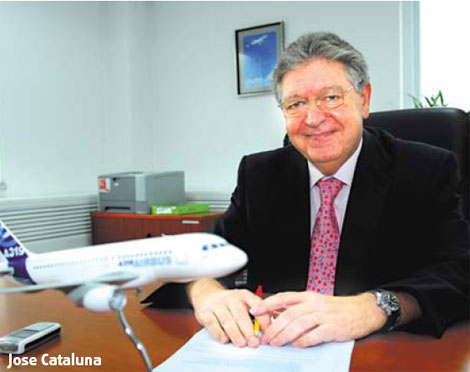|
|
 |
|
30th Anniversary Celebrations
Economic Development
New Rural Reform Efforts
Political System Reform
Changing Lifestyle
In Foreigners' Eyes
Commentary
Enterprise Stories
Newsmakers
Photo Gallery
Video and Audio
Wang Wenlan Gallery
Slideshow
Key Meetings
Key Reform Theories
Development Blueprint
Hong Liang:
Government role decisive for recovery Brendan J. Worrell:
Polish PM earns praise OP Rana:
Saving the Earth more important Li Xing:
Teachers like Li need our support Flying united
By XIAO LU (China Daily)
Updated: 2008-08-18 07:09
 From supplying components, to hosting the site of an aircraft final assembly line, the Chinese aviation industry is increasingly being integrated into Airbus' industrial organization and vying to become a risk-sharing industrial partner of the European aircraft manufacturer. The Airbus (Beijing) Engineering Center recently received a business license as a Sino-foreign joint venture and held its first board meeting. Airbus controls 70 percent of the center, while Hafei Aviation Industry Co Ltd takes the second biggest share with 18 percent and Jiangxi Hongdu Aviation Industry Co Ltd holds 7 percent. China Aviation Industry Corp I (AVIC I) holds the rest of the shares. Hafei and Hongdu are both affiliated to AVIC II. AVIC I and AVIC II are China's leading aviation manufacturers and have been supplying components to Airbus and Boeing. The joint venture will carry out 5 percent of Airbus' outsourced airframe design work of the A350XWB. The A350XWB is Airbus' answer to the runaway success of US rival Boeing's B787 in the lucrative market for long-range, mid-sized, twin-aisle planes. "It will design the components that later on might be manufactured in the different factories of AVIC I and AVIC II. We are giving them the possibility to be full risk sharing partners of Airbus," says Jose Cataluna, general manager of the center. The center has recruited 140 Chinese engineers, including 26 engineers from AVIC II and 14 from AVIC I. The rest are fresh graduates from leading Chinese universities. The center is expected to employ 200 Chinese engineers by the end of this year. "AVIC I and AVIC II have sent the best manufacturing engineers of their plants and the center will train them to become design engineers," Cataluna says. "Our main task is to develop the capability for designing a specific component for an aircraft." The Beijing joint venture is one of Airbus' five outsourced engineering centers around the world. The others are in Wichita, Kansas, and Mobile, Alabama in the United States; Moscow and Bangalore. They are closely linked with Airbus' design offices in Europe. For example, the center in Russia supports Airbus engineering people in Hamburg and Toulouse, focusing primarily on fuselage structure, stress and systems installation. The Wichita center is involved in wing design for the A380 and other long-range aircraft and has real-time communication links with their British colleagues in Filton. "Airbus is trying to become a more and more global company. The way to develop that philosophy is to use the capacity we can develop in each country," Cataluna says. The Toulouse-based aviation manufacturer launched a restructuring plan at the beginning of last year to face challenges such as the US dollar weakness, increased competitive pressure and the financial burden related to the A380 delays. A highlight of the restructuring plan is a new operational model for Airbus to outsource half of A350XWB's aerostructure work to development partners as the aircraft maker seeks better distribution of development costs and risks. This is about twice as much as in the company's earlier programs. Airbus will offer 5 percent of its outsourced work to China. The work packages being proposed are likely to include a high proportion of composite parts, mainly moveable parts on the wing surfaces and the horizontal and vertical tails, flaps and rudders. Airbus will set up a joint venture with Harbin Aircraft Industry Group Co (HAIG), a company affiliated to AVIC II, early next year to produce aircraft composite material parts and components for the A350XWB. The two companies signed a framework contract in July during the 2008 Farnborough International Airshow. Airbus will control 80 percent, while HAIG owns the rest of the shares. Airbus has been increasing its industrial footprint in China. Before 2004 it purchased less than $20 million of its aircraft components per annum from Chinese factories. But by the end of 2007, its subcontracting volume to China exceeded $70 million. The company plans to increase that number to $120 million per annum in 2010 and $450 million per year in 2015, Laurence Barron, Airbus China president, told China Business Weekly earlier this year. "As we look to achieve that target, a very important issue for us is to create a solid team in China for design," Cataluna says. (China Daily 08/18/2008 page6)  
 |
主站蜘蛛池模板: 高清一区二区在线观看 | 视频在线观看一区 | 欧美一级一级片 | 奇米5555| 免费三级毛片 | 久久精品国产三级不卡 | 亚洲黄色美女视频 | 国产高清自拍 | 久久精品资源 | 国产无限制自拍 | 亚洲欧美另类日本久久影院 | 成人第一页| www.久草.com| 99精品视频在线免费观看 | 高清不卡毛片 | 久久亚洲天堂 | 欧美在线日韩在线 | 日韩三级黄色 | 亚洲精品国产一区二区 | 婷婷91 | 性色tv | 亚洲夜| 日本三级免费网站 | 精品国产美女福到在线不卡f | 亚洲国产美女视频 | 亚州成人 | 91亚洲自偷手机在线观看 | 99国产视频| 亚洲欧洲日产国码一级毛片 | 女人毛片a毛片久久人人 | 亚洲精品区 | 国产情侣真实露脸在线最新 | 欧美日韩精品一区二区另类 | 美女性视频网站 | 黄色美女免费看 | 国产一级片观看 | 日韩精品一区二区三区高清 | 日本综合欧美一区二区三区 | 免费观看欧美精品成人毛片能看的 | 精品国产日韩亚洲一区在线 | 草草影院在线观看 |